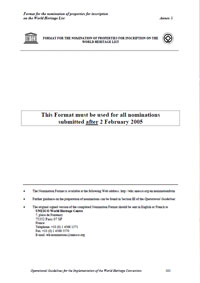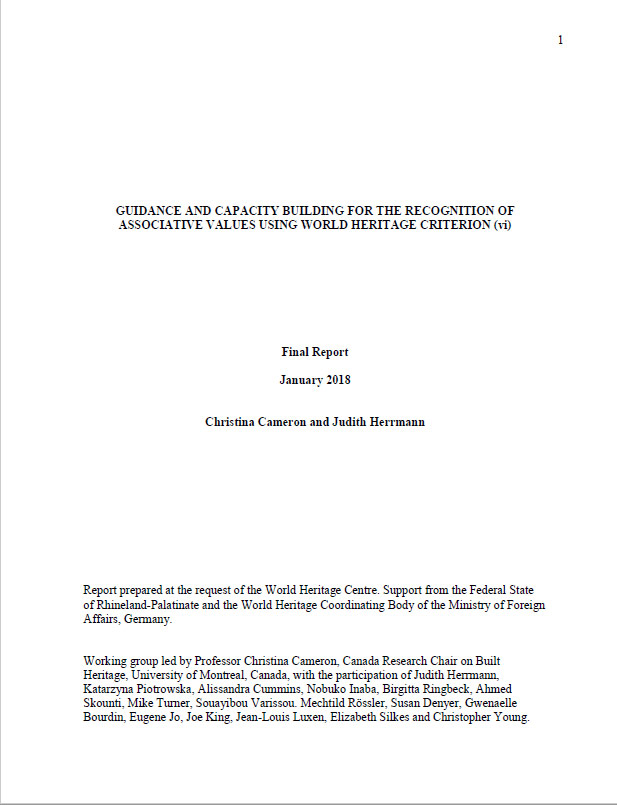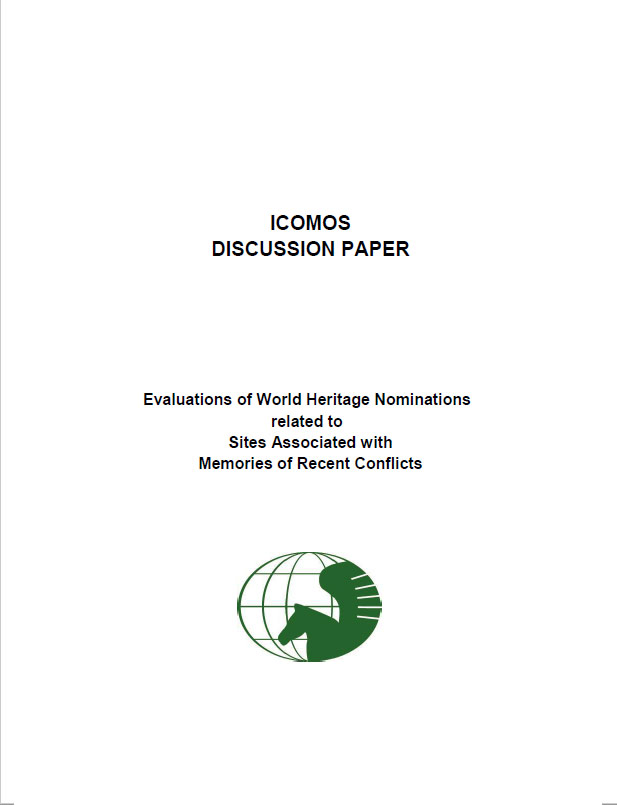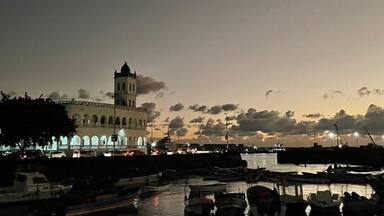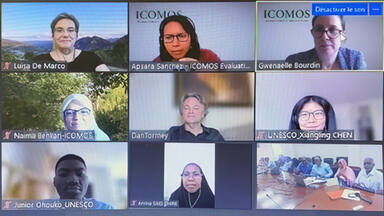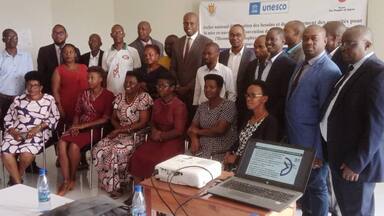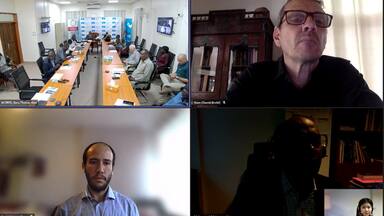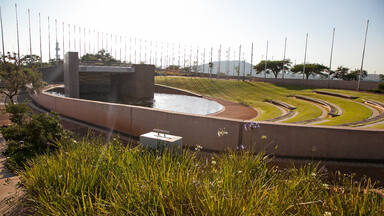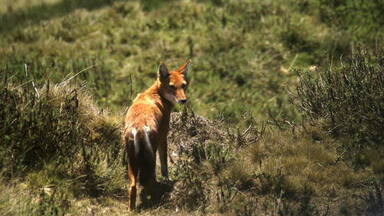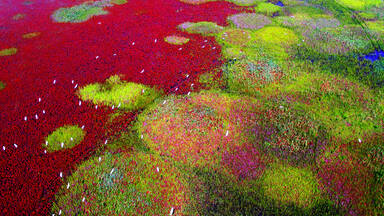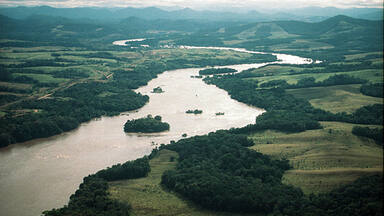World Heritage List Nominations
Only countries that have signed the World Heritage Convention, pledging to protect their natural and cultural heritage, can submit nomination proposals for properties on their territory to be considered for inclusion in UNESCO’s World Heritage List.
Nomination process
The first step a country must take is to make an ‘inventory' of its important natural and cultural heritage sites located within its boundaries. This ‘inventory' is known as the Tentative List, and provides a forecast of the properties that a State Party may decide to submit for inscription in the next five to ten years and which may be updated at any time. It is an important step since the World Heritage Committee cannot consider a nomination for inscription on the World Heritage List unless the property has already been included on the State Party's Tentative List.
By preparing a Tentative List and selecting sites from it, a State Party can plan when to present a nomination file. The World Heritage Centre offers advice and assistance to the State Party in preparing this file, which needs to be as exhaustive as possible, making sure the necessary documentation and maps are included. The nomination is submitted to the World Heritage Centre for review and to check it is complete. Once a nomination file is complete the World Heritage Centre sends it to the appropriate Advisory Bodies for evaluation.
A nominated property is independently evaluated by two Advisory Bodies mandated by the World Heritage Convention: the International Council on Monuments and Sites (ICOMOS) and the International Union for Conservation of Nature (IUCN), which respectively provide the World Heritage Committee with evaluations of the cultural and natural sites nominated. The third Advisory Body is the International Centre for the Study of the Preservation and Restoration of Cultural Property (ICCROM), an intergovernmental organization which provides the Committee with expert advice on conservation of cultural sites, as well as on training activities.
Once a site has been nominated and evaluated, it is up to the intergovernmental World Heritage Committee to make the final decision on its inscription. Once a year, the Committee meets to decide which sites will be inscribed on the World Heritage List. It can also defer its decision and request further information on sites from the States Parties.
To be included on the World Heritage List, sites must be of outstanding universal value and meet at least one out of ten selection criteria. These criteria are explained in the Operational Guidelines for the Implementation of the World Heritage Convention which, besides the text of the Convention, is the main working tool on World Heritage. The criteria are regularly revised by the Committee to reflect the evolution of the World Heritage concept itself.
Until the end of 2004, World Heritage sites were selected on the basis of six cultural and four natural criteria. With the adoption of the revised Operational Guidelines, only one set of ten criteria exists.
Documents
Format for the nomination of properties for inscription on the World Heritage List
Acrobat documents
English French
Nomination dossiers may be submitted at any time during the year, but only those nomination dossiers that are “complete” (see paragraph 132 and Annex 5) and received by the Secretariat on or before 1 February* will be considered for inscription on the World Heritage List by the World Heritage Committee during the following year.
Operational Guidelines annex 5
Format of a Statement of Outstanding Universal Value, and of a retrospective Statement of Outstanding Universal Value
Deadline*: 1 February of the year preceding the one in which the approval of the Committee is requested.
Operational Guidelines annex 10
Form for the submission of contestations concerning a Tentative List entry or a submitted nomination
Word Documents
See Decision 18 EXT.COM 4
Form for the submission of response to contestations concerning a Tentative List entry or a submitted nomination
Word Documents
See Decision 18 EXT.COM 4
Request Format for a Preliminary Assessment of a Potential Nomination to the World Heritage List
Acrobat documents
English French
Operational Guidelines annex 3
Minor modifications to the boundaries of world heritage properties
Deadline*: 1 February of the year in which the approval of the Committee is requested.
Operational Guidelines annex 11
Form for the submission of factual errors in the Advisory Bodies evaluations
Acrobat documents
English French
Deadline: The original signed version of the completed Factual Errors submission form should be received in English or French by the UNESCO World Heritage Centre, no later than 14 days before the opening of the session of the Committee.
Operational Guidelines annex 12
Disclaimer
* If 1 February falls on a weekend, the nomination must be received by 17h00 GMT the preceding Friday
Analysis of the Global Strategy for a Representative, Balanced and Credible World Heritage List (1994‐2020)
Reflection on Sites Associated with Memories of Recent Conflicts and other negative and divisive memories
In view of the increasing number of nominations submitted or under preparation related to sites associated with memories of recent conflicts, the World Heritage Committee at its 42nd session (Manama, 2018) in three of its decisions requested to undertake a comprehensive reflection and convene an Expert Meeting on sites associated with memories of recent conflicts.
Received
Proposed for review
Cultural, Natural, Mixed
Decisions (5)
The World Heritage Committee,
1. Having examined Documents WHC/23/18.EXT.COM/4 and WHC/23/18.EXT.COM/INF.4,Part I - Guiding Principles
2. Recalling Decisions 42 COM 8B.24 and 44 COM 8 adopted at its 42nd (Manama, 2018) and the extended 44th (Fuzhou/online, 2021) sessions respectively,
3. Considering the fruitful debates held during the meetings of the Open-ended Working Group established at its extended 44th session (Fuzhou/online, 2021) to broaden the scope of the reflection on sites of memory associated with recent conflicts,
4. Also recalling that the World Heritage List is intended to ensure the protection of only a select list of the most outstanding sites from a comparative and a universal viewpoint,
5. Recognizing that not all sites of memory associated with recent conflicts could satisfy the threshold of the Outstanding Universal Value, as with all other sites,
6. Also recognizing that the inscription of sites of memory associated with recent conflicts should serve the peace building mission of UNESCO, and emphasizing the importance of an agreement through dialogue among the concerned State(s) Party(ies) upon all nominations in this regard,
7. Encourages States Parties and Advisory Bodies in collaboration with the World Heritage Centre to seek to address their skill gaps and to strengthen their competencies, as well as those of managers, communities and local communities in order to address the particular challenges of sites of memory associated with recent conflicts, including the preparation of nominations and the future interpretation of these sites;
8. Decides to lift the moratorium on the evaluation of sites of memory associated with recent conflicts and also decides that the nominations of such sites for inscription on the World Heritage List may be evaluated on a case-by-case basis;
9. Further decides that nominations of sites of memory associated with recent conflicts, submitted by 1 February 2022 and considered complete[1], will be processed under the procedures and criteria applicable at the time of their submission;
10. Decides furthermore to suspend the application of Paragraphs 61 and 122 of the Operational Guidelines for the nominations of sites of memory associated with recent conflicts, submitted by 1 February 2022 and considered complete1;
11. Notes that the Guiding Principles proposed by the Open-ended Working Group were elaborated with the understanding that:
i. The term “conflict” is considered to cover events such as wars, battles, massacres, genocide, torture, military occupations, movements of self-determination, resistance movements, liberation movements from colonization, apartheid and occupation, exile, deportation and mass violations of human rights and events or actions that could potentially impact the territorial integrity of States.
ii. The term "recent" generally relates to events having occurred from the turn of the twentieth century, it being understood that the sensitive nature of memories resulting from conflict can endure for centuries beyond that temporal framework.
iii. Sites of memory are places where an event happened that a nation and its people (or at least some of them) or communities want to remember. Sites associated with recent conflicts are specific sites with material evidence, in conformity with Articles 1 and 2 of the Convention, or landscape features which can be linked to their memorial aspect and that commemorate the victims of these conflicts. These sites, accessible, or made accessible, to the public, represent a place of reconciliation, remembrance, peaceful reflection, and must play an educational role in order to promote a culture of peace and dialogue.
12. Adopts the following Guiding Principles applicable to sites of memory associated with recent conflicts that are nominated under criterion (vi), preferably in conjunction with other criteria, as defined in paragraph 77 of the Operational Guidelines, having in mind that the Guiding Principles are consistent with the UNESCO Constitution, the World Heritage Convention, and the Operational Guidelines;
Guiding Principles:
a) The nomination text will include the assessment of the use of criterion (vi) carried out in three distinct phases. First, the outstanding universal significance of the association must be demonstrated; secondly, the nature of the direct or tangible link between the association and the site must be described; thirdly, a comparative analysis to other sites with similar associations and their links to the site needs to be carried out.
b) The nomination text will include the assessment of the authenticity of the physical site and of the link to the associated memories. Bearing in mind potential differing views, factual accuracy must be demonstrated to avoid distortion of memories. In addition, it has to be shown that efforts were made to address and minimize any dissonance that may occur at the local, national, regional, and international levels.
c) The nomination text shall include documentation that serious efforts have been made to ensure inclusive and effective participation of all potentially affected stakeholders in the process of preparation of the nomination and their agreement on the meaning, values and interpretation of the nominated property. The nominating State(s) Party(ies) is/are responsible for identifying all potentially affected stakeholders that need to be involved throughout the development of the nomination and in the ensuing process. Potentially affected stakeholders include, inter alia, other concerned States Parties, local communities where sites are located, communities of interest, local governments, right-holders and others.
d) The nomination text will include a dedicated sub-section titled “Interpretation strategy”. Bearing in mind potential differing views and narratives, the interpretation strategy shall be multi-dimensional to present accurately the full meaning of the site and to support an understanding of its full history. The physical location at the place where conflict has taken place and means of interpretation will be part of the interpretation strategy. The interpretation strategy shall embrace the place’s historical past and its present-day meanings, in a dialogue and peace-building perspective. It needs to discuss how the stakeholders concerned with the site intend to take into account the debates on issues of current concern that connect to the themes of the The strategy should describe efforts made so that stakeholders who have an interest in the site will be engaged in the development of interpretation for the site.
e) The nomination text, under a dedicated sub-section titled “Education and information programmes”, will include evidence of educational and information programmes meeting the same high ethical and scholarly standards of the UNESCO Global Citizenship Education programme, such as the inclusion of multiple narratives based on sound research and comparative analysis using documentary and archival sources, testimonies and material evidence. Sites of memory associated with recent conflicts have the potential to teach preventive lessons and promote reconciliation and peace. On the other hand, sites where the values are still contested may unduly favour one narrative over others, leading to exclusion and injustice and fostering divisiveness, not peace.
f) The nomination text shall document the reconciliation process and demonstrate that the nomination of the site is not interrupting the process of dialogue and reconciliation. Bearing in mind that for sites of memory associated with recent conflicts, reconciliation can be a slow and painful process, the values proposed as potential Outstanding Universal Value in these nominations should encourage the ongoing process of dialogue and reconciliation in relation to the concerned conflict.
13. Also encourages State(s) Party(ies) responsible for nominations processed under existing procedures and criteria1, to do their utmost to implement the Guiding Principles identified in relation to interpretation, education and information and reconciliation;
Part II - Mechanism to notify a contestation
14. Considering that nomination files are produced by the concerned States Parties, the sole responsibility for the content of each nomination file lies with the State Party concerned; the receipt, processing and publication of the nomination file does not imply the expression of any opinion whatsoever of the World Heritage Committee or of the Secretariat of UNESCO concerning the history or legal status of any country, territory, city or area or of its boundaries,
15. Keeping in mind that “the purpose of UNESCO is to contribute to peace and security by promoting collaboration among the nations through education, science and culture in order to further universal respect for justice, for the rule of law and for the human rights and fundamental freedoms which are affirmed for the peoples of the world, without distinction of race, sex, language or religion, by the Charter of the United Nations” (Article I, UNESCO Constitution),
16. Also adopts the following contestation mechanism for Tentative List entries and submitted nominations, applicable to sites of memory associated with recent conflicts that are nominated under criterion (vi), preferably in conjunction with other criteria, as defined in paragraph 77 of the Operational Guidelines:
a) Contestation concerning a Tentative List entry
A State Party may contest an existing or newly submitted Tentative List entry, formally, in writing, using the form available on the World Heritage Centre’s website. The World Heritage Centre will confirm the receipt of the notification of contestation and transmit a copy to the submitting State(s) Party(ies), and to the relevant Advisory Body(ies). The notification of contestation will be provided to the World Heritage Committee as an information document for noting under Item 8A Tentative List at the following World Heritage Committee meeting. The World Heritage Centre will facilitate dialogue among the concerned States Parties.
b) Contestation concerning a newly submitted nomination
On 31 March (year 1), newly submitted nominations that are considered complete are uploaded on the World Heritage Centre’s website and made available for all States Parties.
State(s) Party(ies) may submit a contestation up to 30 June (year 1) at the latest. The contesting State(s) Party(ies) shall express formally, in writing, its contestation to the World Heritage Centre using the established form available on the World Heritage Centre’s website. The World Heritage Centre will transmit the submitted contestation to the nominating State(s) Party(ies).
The nominating State(s) Party(ies) may respond to the contestation formally, in writing, to the World Heritage Centre using the established form available on the World Heritage Centre’s website by 30 September (year 1) at the latest. The World Heritage Centre will transmit the response to the contestation to the contesting State(s) Party(ies).
The World Heritage Centre will facilitate dialogue among the concerned States Parties. The notification of contestation and any response to the notice of contestation from the nominating State(s) Party(ies) will be provided to the World Heritage Committee as an information document under Item 8B Nominations to the World Heritage List, therefore, no further notifications could be integrated in the formal contestation beyond the limit of six weeks prior to the World Heritage Committee’s session.
In case the concerned States Parties reach an agreement, the nominating State(s) Party(ies) will submit evidence documenting their agreement on contested matters to the Committee as additional information to its own nomination by 28 February (year 2).
Where no agreement has been reached, with due regard to the Committee's prerogatives, and unless otherwise decided by the Committee, it should request the concerned States Parties to continue their dialogue.
Whatever the outcome of the continued dialogue, the nomination file will be re-examined at the following session of the World Heritage Committee.
17. Decides moreover to amend the relevant parts of paragraphs 140 and 168 (1 February – 1 March Year 1) of the Operational Guidelines as follows:
The Secretariat will also make available the electronic format of the text of the nomination dossiers to the Members of the Committee on the World Heritage Centre’s website.
Part III – Implementation of the present decision
18. Also decides that, in reference to the nominations mentioned in paragraph 9 above and taking into account the exceptional circumstances which affected the timetable for such nominations, the procedures will be applied so as to allow, for those States Parties which have requested it at the present extraordinary session, the examination of their nominations by the Committee at its 45th session.[1] Notably: Funerary and memorial sites of the First World War (Western Front), Belgium and France / The Landing Beaches, Normandy, 1944, France / Brâncusi Monumental Ensemble of Târgu Jiu, Romania / Genocide memorial sites: Nyamata, Murambi, Gisozi and Bisesero, Rwanda / Human Rights, Liberation and Reconciliation: Nelson Mandela Legacy Sites, South Africa / ESMA Museum and Site of Memory – Former Clandestine Center of Detention, Torture and Extermination, Argentina.
Read more about the decisionThe World Heritage Committee,
1. Recalling the conclusions on the "Evaluation of the Cairns Decision" by the 27th session (Decision 27 COM 14), the Decision adopted on the Representivity of the World Heritage List at its 24th session ("Cairns Decision", 2000), subsequently endorsed by the General Assembly of State Parties at its 13th session (2001); and the Resolution on ways and means to ensure a representative World Heritage List adopted by the General Assembly at its 12th session (1999),
2. Further recalling that the World Heritage Convention establishes a system of international co-operation and assistance for the protection of the World Cultural and Natural Heritage,
3. Recognising the need to increase the technical and administrative capacity of the World Heritage systems, to encourage growth of under-represented categories and geographical coverage, and acknowledge the work constraints of the Committee, the Advisory Bodies, World Heritage Centre and States Parties to achieve this objective,
4. Noting with interest the results of the ICOMOS and IUCN analyses, as well as additional analyses undertaken by the World Heritage Centre as presented in document WHC-04/28.COM/13,
5. Concerned in particular with the conclusion that constraints and gaps in the World Heritage List primarily relate to lack of technical capacity to prepare adequate assessments and inventories of heritage properties, to promote and prepare nominations and relate to the lack of an appropriate legal and management framework;
6. Emphasizing that Tentative Lists are an effective and indispensable tool in the identification of potential World Heritage properties at national and (sub)regional level, and thereby contributing to the representativity of the World Heritage List,
7. Considering that these concerns are already essential elements of the "Cairns Decision" that have, however, not been fully implemented,
8. Further emphasizing that all issues addressed by the "Cairns Decision" need full and adequate implementation and that the World Heritage Centre and States Parties in the coming years should focus on those elements that have not been sufficiently addressed such as the development of balanced Tentative Lists and capacity building,
9. Recalls that the Committee had previously decided:
a) to make available to all stakeholders all appropriate statutory World Heritage documentation, including documentation on the pre-, during and post-inscription process of World Heritage properties,
b) to encourage the increased participation of local authorities, civil society organizations and populations in the identification of the cultural and natural heritage of States Parties,
c) to implement regional, and, as appropriate, sub-regional programmes based on results of Periodic Reporting to increase the State Parties' capacity for the identification, nomination, and conservation of World Heritage properties,
d) to encourage States Parties to initiate and complete national inventories for cultural and natural heritage,
e) to review the effectiveness and appropriateness of national legal and institutional frameworks and policies and to provide advice to States Parties, upon their request, on reform of national, legal and institutional frameworks and policies,
f) to identify national, regional and international existing institutions, facilities and networks that offer training in heritage conservation and management and that can participate in the implementation of capacity building strategies and programmes;
10. Considers that capacity-building should be strategic, comprehensive, and institutionalised, and that it should focus, in particular on the identification of potential properties, preparation of representative Tentative Lists, preparation of nominations, conservation action and management of properties;
11. Calls upon
a) States Parties, the World Heritage Centre and other partners to significantly increase their support to States Parties, in particular those less represented in the List, in the identification of cultural, natural and mixed properties of potential outstanding universal value, as well as in the preparation of nomination dossiers ;
b) the Advisory Bodies (ICOMOS, ICCROM, IUCN) to increase their support to States Parties, in particular those less represented in the List, in the identification of cultural, natural and mixed properties of potential outstanding universal value;
12. Requests IUCN and ICOMOS to complete their analyses of the Tentative Lists, work on the gaps in the World Heritage List with due consideration to all States Parties and regions of the world and continue their thematic studies;
13. Further requests the World Heritage Centre, in co-operation with States Parties, ICOMOS, IUCN, ICCROM, appropriate scientific institutions, selected governmental and non-governmental experts, appropriate ntergovernmental and non-governmental organizations and other relevant partners, to convene, as soon as possible and not later than March 2005, a special meeting of experts of all regions with the following aims:
a) make specific proposals to enable States Parties to better identify natural, cultural and mixed properties of potential outstanding universal value. Such proposals should include a reflection on the concept of Outstanding Universal Value as defined by the World Heritage Convention and in the context of regions, including cultural and biogeographical regions – and, as appropriate, sub regions -, with a view to compiling representative Tentative Lists, as well as the elaboration of a comparative analysis and evaluation of the Tentative Lists, and a compilation of best practices in the preparation of such lists. At a minimum, the proposals should generate the conditions to ensure that by 2007 all States Parties have submitted Tentative Lists, which are substantially in accordance with Article 11 of the World Heritage Convention and its Operational Guidelines,
b) in the framework of Article 7 of the World Heritage Convention, make specific proposals to enable less-represented and non-represented States Parties to improve the quality of nominations and, consequently, the success rate of inscriptions on the World Heritage List of properties from such States Parties. At a minimum, by 2007 the proposals should lead to a decrease of at least 30% in the number of such less-represented and nonrepresented States Parties,
c) in the framework of Article 7 of the World Heritage Convention, make specific proposals to enable States Parties - in particular those lessrepresented and non-represented - to identify sufficient funding sources for the sustainable conservation of the properties thus inscribed. Such proposals could include the creation of inter-institutional and inter-sectoral site commissions and the networking of properties in order to ensure their adequate monitoring, management, including traditional management mechanisms, involvement of local populations and sustainable conservation. At a minimum, by 2007 the proposals should lead to the removal from the World Heritage List in Danger of at least 20% of the properties inscribed on that List,
d) on the basis of the refinement of the analysis referred to in paragraph 4 make specific proposals for the follow–up of such analysis. At a minimum, by 2007 such proposals should lead to the elaboration of regional – and, as appropriate, sub regional- programs, as well as to the adoption and harmonization of regional – and, as appropriate, sub regional- action plans fully consistent with the pertinent periodic reports;
14. Takes note of the offer by the Russian Federation to host the special meeting of experts of all regions referred to in paragraph 13 above;
15. Further requests the World Heritage Centre to report on the proposals and conclusions of the special meeting of experts of all regions referred to in paragraph 13, for consideration by the Committee at its 29th session (2005);
16. Decides to apply at its 29th session (2005) the mechanism set out in paragraphs 1 to 5 of Decision 27 COM 14, and requests the World Heritage Centre to distribute as soon as possible the full list of nominations admissible for examination by such session;
17. Also decides, on an experimental and transitory basis, to apply the following mechanism at its 30th session (2006):
a) examine up to two complete nominations per State Party, provided that at least one of such nominations concerns a natural property; and,
b) set at 45 the annual limit on the number of nominations it will review , inclusive of nominations deferred and referred by previous sessions of the Committee, extensions (except minor modifications of limits of the property), transboundary nominations, serial nominations and nominations submitted on an emergency basis,
c) the order of priorities for the examination of new nominations shall remain as decided by the Committee at its 24th session (2000):
(i) nominations of properties submitted by States Parties with no properties inscribed on the List,
(ii) nominations of properties from any State Party that illustrate unrepresented or less represented categories of natural and cultural categories,
(iii) other nominations,
(iv) when applying this priority system, date of receipt of full and complete nominations by the World Heritage Centre shall be used as secondary determining factor within the category where the number of nomination fixed by the Committee has been reached;
18. Further decides to examine the transitory mechanism set out in paragraph 17 at its 31st session (2007), on the basis of:
a) the results of the process set out in paragraphs 13 and 15 above,
b) the extent to which the nominations presented at its 30th session (2006) contribute to the aim of a representative World Heritage List.
Read more about the decisionThe World Heritage Committee,
- Requests the World Heritage Centre to ensure that all future publications of the World Heritage List indicate the criteria according to which properties were inscribed on the List using the new numbering system for the combined criteria (i) to (x).
VI.1 The Committee noted the reports of the following four reform groups and sincerely thanked the States Parties who had participated in their work.
Task Force on the implementation of the Convention
Chair: C. Cameron (Canada)
Rapporteur: K. Keeffe (Australia)
WHC-2000/CONF.2000/INF. 7
Working Group on the Representativity of the World Heritage List
Chair: H.E. Ambassador Mr Olabiyi B.J. Yai (Benin)
Rapporteur: H.E. Mr M. Peek (Australia)
WHC-2000/CONF.2000/INF. 8
Working Group on Equitable Representation in the World Heritage Committee
Chair: H.E. Ambassador J. Musitelli (France)
Rapporteur: D. Masek (Czech Republic)
WHC-2000/CONF.2000/INF.9
International Expert Meeting on the Revision of the Operational Guidelines, Canterbury, United Kingdom (10-14 April 2000)
Chair: C. Young (United Kingdom)
Rapporteur: K. Kovacs (United States of America)
WHC-2000/CONF.2000/INF.10
VI.2 In view of the large number of detailed recommendations prepared by the four groups listed above, and given that there was limited time for discussion, the Committee focused its discussions on the reform process by examining four specific issues as follows:
1. PROPOSED REFORM OF THE CALENDAR AND CYCLE OF WORLD HERITAGE STATUTORY MEETINGS AND FEASIBILITY STUDY OF THE PROPOSED SYSTEM OF SUB-COMMITTEES
The Committee recalled that the Task Force for the Implementation of the Convention, chaired by Ms Christina Cameron (Canada), had proposed that sub-committees be established to facilitate the work of the World Heritage Committee and the World Heritage Centre.
The Committee also recalled that the twenty-fourth session of the Bureau (June 2000) had requested that there be further examination of the possibility of a sub-committee system and that the Special Session of the Bureau (Budapest, 2-4 October 2000) had discussed the proposal further with reference to a paper prepared by the United Kingdom.
As requested by the Special Session of the Bureau, a paper on the feasibility and implications of a sub-committee system was prepared and examined by the twenty-fourth extraordinary session of the Bureau (WHC-2000/CONF.203/6).
The four objectives for proposing changes to the existing Bureau and Committee system were to:
Objective 1 Facilitate the work of the World Heritage Centre, Objective 2 Facilitate the work of the World Heritage Committee and allow it to devote more time to general policy discussions for the implementation of the Convention, Objective 3 Improve the prior examination of various issues submitted to the Committee, and Objective 4 Increase representation of States Parties in the work of the Committee.
The Committee decided to:
- Revise the calendar and cycle of World Heritage meetings from June/November to April/June (see Annex VIII)
- Abolish the extraordinary sessions of the Bureau and Committee
- Implement changes to the calendar and cycle of the Bureau and the Committee in 2002 (Note: Hungary, who hopes to be host country to the Committee in 2002, expressed their agreement to this date for the introduction of a new calendar and cycle)
- Introduce an Item A and B decision-making system (Item A: items which are the subject of consensus for adoption and, Item B: items requiring discussion by the Committee)
- Enforce Rule 22.2 of Committee's Rules of Procedure to limit the time allowed to each speaker (especially if they are an observer)
- Defer the examination of nominations received in 2001 to the year 2003. This deferral would imply only a limited pause (7 months) in the nomination process, and allow the necessary transitional adjustments
- Introduce a biennial budget for the World Heritage Fund to harmonize with the UNESCO budget cycle
- Review any changes to the calendar, cycle and meetings of the Bureau (or sub-committees) and the Committee after they have been in operation for 4 years
The revised deadline for nominations would be 1 February. Evaluations would be due from IUCN and/or ICOMOS 6 weeks prior to the April Bureau.
Referrals of nominations would be re-examined by the Bureau in the year following initial examination before proceeding to the Committee for decision.
The deadline for receipt of international assistance requests and state of conservation reports would also be on 1 February.
During the transition period the following timetable would apply:
| Nominations received by | To be examined by the Bureau | To be examined by the Committee |
|---|---|---|
| 1 July 2000 | June/July 2001 | December 2001 |
| 31 December 20001 | April 2002 | June 2002 |
| 1 February 2002 | April 2003 | June 2003 |
| 1 February 2003 | April 2004 | June 2004 |
The Committee decided to defer a decision on the introduction of a sub-committee system or the extension of the Bureau session from six to eight days, until the effectiveness of the other reforms (changed statutory meeting calendar and cycle, limitation in number of nominations to be examined each year and reforms to meeting documentation) could be assessed at a later date. It was thus agreed that reform should proceed gradually. Greater efforts were to be given to structuring the work of the Bureau to focus its work. The ordering of the agenda by topics was considered useful as was the use of informal ad hoc working groups to expedite the work of the Bureau and Committee.
The Delegate of Hungary presented a document distributed to the Committee entitled "A Hungarian World Heritage Vision". The document refers to the need to address the balance of representation of the World Heritage List in favour of under- represented or non-represented countries. It also calls for a more prominent role for tentative lists. The Delegate of Hungary suggested that with a pause in the examination of nominations in 2002, the twenty-sixth session of the Committee in 2002 could concentrate on the preparation of a Strategic Plan and other issues important for the future implementation of the Convention.
Documentation
The Committee noted that the Task Force on the Implementation of the World Heritage Convention had recommended a number of reforms to the documents prepared for World Heritage statutory meetings.
Following a presentation by the Director of the World Heritage Centre, the Committee agreed that the objectives of reforming meeting documentation would be to:
- facilitate decision-making and increase efficiency
- streamline document preparation
- provide transparency and equity of access to documentation
- reduce costs.
The Committee decided that reform of the system of documentation, as proposed by the Director of the World Heritage Centre, would include:
- maintaining Reports of the Rapporteurs
- reducing the number of working documents by compiling one decision-making guide to be distributed 2 weeks prior to the meeting
- including additional working documents only in exceptional cases - e.g. Strategic Planning documents, or changes to Reference Texts (Operational Guidelines, Rules of Procedure etc.)
- all other documents as Information Documents.
To enhance communication between the World Heritage Centre and the Committee, the Committee also decided, as proposed by the Director of the World Heritage Centre, that the Centre would,
- prepare a regular report referencing documents currently available
- organize two information meetings per year for Committee members at UNESCO Headquarters (non-Committee members to attend as observers)
- continue to prepare a Secretariat Report to the Bureau and Committee but improve its structure and content.
The Committee requested the World Heritage Centre to implement as many of these reforms as are feasible before the twenty-fifth session of the Committee.
2. EQUITABLE REPRESENTATION IN THE WORLD HERITAGE COMMITTEE
The Committee recalled that in October 1999 the twelfth General Assembly,
- adopted by consensus a Resolution underlining the importance of an equitable representation of the World Heritage Committee and the need to increase the number of its members
- requested the World Heritage Committee to submit proposals on this matter to the thirteenth General Assembly of States Parties and to inscribe an item on the agenda of the thirty-first General Conference in 2001.
The Committee noted that in 2000, a Working Group on Equitable Representation within the World Heritage Committee was established under the Chairmanship of H.E. Ambassador J. Musitelli (France). The report of the Working Group was discussed at the June and October 2000 sessions of the Bureau (WHC-2000/CONF.204/INF.9).
The Committee noted the proposals on the equitable representation of the Committee developed following the Special Session of the Bureau session (WHC-2000/CONF.204/6) and decided to recommend the following Draft Resolution for adoption by the 13th General Assembly:
The General Assembly of States Parties to the Convention concerning the protection of the World Cultural and Natural Heritage,
Recalling Article 8, paragraph 2, of the Convention which stipulates that "Election of members of the Committee shall ensure an equitable representation of the different regions and cultures of the world";Recalling Article 9 of the Convention which stipulates that "The term of office of States members of the World Heritage Committee shall extend from the end of the ordinary session of the General Conference during which they are elected until the end of its third subsequent ordinary session";
Recalling the Resolution of the 7th General Assembly of States Parties (1989);
Considering the representivity of the World Heritage List could be enhanced through the increased participation in the work of the Committee of States Parties whose heritage is currently unrepresented in the List;
Considering that the strong interest of States Parties in participating in the work of the World Heritage Committee could be addressed by a more frequent rotation of Committee members;
Invites the States Parties to the World Heritage Convention, to voluntarily reduce their term of office from six to four years;
Encourages States Parties that are not members of the Committee to make use of their right to participate in meetings of the World Heritage Committee as observers;
Discourages States Parties from seeking consecutive terms of office in the World Heritage Committee;
Decides that before each election of Committee members, the President of the General Assembly of States Parties will inform States Parties of the situation of the representation of regions and cultures in the World Heritage Committee and World Heritage List;
Decides to amend its Rules of Procedure as follows:
New Rule to be inserted after Rule 13.1
A certain number of seats may be reserved for State Parties who do not have sites on the World Heritage List, upon decision of the World Heritage Committee at the session that precedes the General Assembly. Such a ballot for reserved seats would precede the open ballot for the remaining seats to be filled. Unsuccessful candidates in the reserved ballot would be eligible to stand in the open ballot.
Amendment to existing Rule 13.8 (new text in bold)
13.8 Those States obtaining in the first ballot the required majority shall be elected, unless the number of States obtaining that majority is greater than the number of seats to be filled. In that case, the States obtaining the greatest number of votes, up to the number of seats to be filled, shall be declared elected. If the number of States obtaining the majority required is less than the number of seats to be filled, there shall be a second ballot, followed by a third and, if necessary a fourth, to fill the remaining seats. If the number of States obtaining the majority required is less than the number of seats to be filled, there shall be a second ballot. If the number of States obtaining the majority required is still less than the number of seats to be filled there shall be a third and, if necessary a fourth ballot, to fill the remaining seats. For the third and fourth ballots, the voting shall be restricted to the States obtaining the greatest number of votes in the previous ballot, up to a number twice that of the seats remaining to be filled.
Decides that this resolution should be implemented immediately.
The Committee also recommended that the General Assembly organize the agenda of its thirteenth session so that the measures foreseen by these amendments may enter into force at that same session.
In order to implement the new rule to be inserted following Rule 13.1, the Committee decided that one seat be reserved for a State Party not having a site inscribed on the World Heritage List at the date of the thirteenth session of the General Assembly.
The Committee requested the Secretariat to inform all States Parties of the implementation of the new electoral procedures, particularly those States Parties which may fulfill the conditions to be candidates for the reserved seat.
The Committee requested the Secretariat to prepare with the involvement of interested States Parties and the advisory bodies, a proposal for the twenty-sixth session of the World Heritage Committee for further amendment to Rule 13 of the Rules of Procedures of the General Assembly relating to the election of members of the World Heritage Committee in order to ensure an equitable representation of the different regions and cultures of the world. This proposal is to be based on a thorough analysis of the consequences of the proposed changes and the adjustments that would be required to the election procedures.
The Committee also decided to revise the Rules of Procedure of the World Heritage Committee as follows:
New Rule 4.3"In determining the place of the next session, the Committee shall give due regard to the need to ensure an equitable rotation among the different regions and cultures of the world."
New Rule 20.4
"In appointing consultative bodies, due regard shall be given to the need to ensure an equitable representation of the different regions and cultures of the world."
New Rule 21.3
"In appointing subsidiary bodies, due regard shall be given to the need to ensure an equitable representation of the different regions and cultures of the world."
3. REPRESENTIVITY OF THE WORLD HERITAGE LIST
The Committee examined and discussed the recommendations of the Working Group on the Representivity of the World Heritage List chaired by Ambassador Yai (Benin), which had been transmitted by the Special Session of the Bureau with some changes.
The Committee recognized that the issue of representivity of the World Heritage List was the most difficult of the reform issues under consideration by the Committee. The Committee noted that more effective use of tentative lists and greater regulation of the ever-increasing number of nominations was required. It was agreed that other measures, such as assistance for capacity-building would be vital for ensuring the representation of sites from all regions on the World Heritage List.
The Committee therefore agreed on a decision presented in 5 sections:
- Respecting the Convention
- Tentative Lists
- Nominations
- Resolution of the Twelfth General Assembly, 1999
- Capacity Building for under-represented Regions
With reference to Section 3, the Delegate of Hungary asked that his request for a change in the deadline for submission of nominations to be examined in 2002, from December 2000 as agreed by the Committee, to April 2001, be noted in the Report. The Committee agreed to note this request by the Delegate of Hungary but stated that in the interest of a smooth transition, the majority position of the Committee will be maintained.
With the exception of Hungary, the text of the decision was adopted by all members of the Committee. A letter from the Italian Government is included as Annex IX of this report.
The Committee agreed to transmit its decision to the Thirteenth General Assembly of States Parties in 2001.
1. Respecting the Convention
The Committee reaffirmed the Convention for the Protection of the World Natural and Cultural Heritage as an instrument of consensus, cooperation and accord between States Parties and takes particular note of Articles 6 (1) and 6 (2) and Article 11 (1):
(i) Whilst fully respecting the sovereignty of the States on whose territory the cultural and natural heritage mentioned in Articles 1 and 2 is situated, and without prejudice to property right provided by national legislation, the States Parties to this Convention recognize that such heritage constitutes a world heritage for whose protection it is the duty of the international community as a whole to co-operate (Article 6 (1)(ii) The States Parties undertake, in accordance with the provisions of this Convention, to give their help in the identification, protection, conservation and presentation of the cultural and natural heritage . . . if the States on whose territory it is situated so request (Article 6 (2)).
(iii) Every State Party to this Convention shall, in so far as possible, submit to the World Heritage Committee an inventory of property forming part of the cultural and natural heritage, situated in its territory and suitable for inclusion in the list . . . (Article 11 (1).
Decisive cooperative action is required by the Committee and States Parties to ensure that the World Heritage List is fully representative of the world's natural and cultural heritage.
2. Tentative Lists
(i) In the future, consistent with Article 11, .the tentative lists of cultural and natural sites should be used, as a planning tool to reduce the imbalances in the World Heritage List. States Parties are reminded of the invitation to submit tentative lists in conformity with Article 11 of the Convention. The Committee should revise paragraphs 7 and 8 of the Operational Guidelines to extend to natural sites its decision not to examine nominations of sites for inscription if the property does not appear on a tentative list.
(ii) The advisory bodies and the World Heritage Centre should proceed with an analysis of sites inscribed on the World Heritage List and the tentative list on a regional, chronological, geographical and thematic basis. This analysis should be undertaken as soon as possible, taking into account the workload on advisory bodies and the financial implications of this work, particularly in regard to the large number of sites on the tentative list. For this reason, the work should be undertaken in two parts, sites inscribed on the World Heritage List and sites on the tentative list. The analysis will provide States Parties with a clear overview of the present situation, and likely trends in the short to medium term with a view to identifying under-represented categories.
(iii) The advisory bodies should take into account in their analyses:
- The diversity and particularities of natural and cultural heritage in each region,
- The results of regional Periodic Reporting, and
- The recommendations of the regional and thematic meetings on the harmonisation of tentative lists held since 1984 and those on the Global Strategy organised since 1994.
(iv) The World Heritage Centre and advisory bodies should communicate the results of the analyses to the World Heritage Committee and, following the Committee's examination, the results should be conveyed to States Parties to the Convention, together with the Committee's recommendations. This will allow them to prepare, revise and/or harmonise their tentative list, taking into account, where appropriate, regional considerations, and to take the results of the analyses into consideration for the submission of future nominations.
(v) The results of the analyses should be communicated no later than 30 September 2001.
In order to promote the effective management of the increasing size of the World Heritage List, the Committee at each ordinary session will set the maximum number of nominations to be considered. In the first instance and on an interim basis, it is proposed that at the twenty-seventh session of the Committee in 2003, the number of nominations examined by the Committee will be limited to a maximum of 30 new sites.
In order to determine which sites should be given priority for consideration, all nominations to be considered at the twenty- seventh session of the Committee must be received in full by the new due date of 1 February 2002 agreed by the Committee as part of the change of cycle of meetings. No State Parties should submit more than one nomination, except those States Parties that have no sites inscribed on the World Heritage List who will have the opportunity to propose two or three nominations.
In order to address the issue of representivity of the List the following criteria will be applied in order of priority:2
In the event that the number of nominations received exceeds the maximum number set by the Committee, the following priority system will be applied each year by the World Heritage Centre before nominations are transmitted to the advisory bodies for evaluation, in determining which sites should be taken forward for consideration:
- Nominations of sites submitted by a State Party with no sites inscribed on the List;3
- Nominations of sites from any State Party that illustrate un-represented or less represented categories of natural and cultural properties, as determined by analyses prepared by the Secretariat and the Advisory Bodies and reviewed and approved by the Committee;
- Other nominations.
When applying this priority system, date of receipt of full and complete nominations by the World Heritage Centre shall be used as the secondary determining factor within the category where the number of nominations established by the Committee is reached.
In addition to the approved maximum number of sites, the Committee will also consider nominations deferred, or referred, from previous meetings and changes to the boundaries of already inscribed properties. The Committee may also decide to consider, on an emergency basis, situations falling under paragraph 67 of the Operational Guidelines.
Transition arrangements
Committee meeting, December 2001No change to existing system.
Committee meeting June 2002
Full and complete nominations received by the World Heritage Centre prior to 31 December 2000 will be considered together with nominations deferred, or referred, from previous meetings and changes to the boundaries of already inscribed properties. The Committee may also decide to consider, on an emergency basis, situations falling under paragraph 67 of the Operational Guidelines.
Committee meeting June 2003
Nominations to be submitted by 1 February 2002 and prioritized in accordance with the system as described above.
Review
The system described above is to be reviewed by the Committee after two full years of operation.
4. Resolution of the Twelfth General Assembly, 1999
The Committee decided to call on States Parties concerned to inform the Committee with a minimum of delay, of measures taken in the implementation of the clauses of the Resolution adopted by the Twelfth General Assembly (Paragraph B) that invites all States Parties that already have a substantial number of sites inscribed on the World Heritage List to:
(i) Apply paragraph 6 (vii) of the Operational Guidelines for the Implementation of the World Heritage Convention:
- by spacing voluntarily their nominations according to conditions that they will define, and/or
- by proposing only properties falling into categories still under-represented, and/or
- by linking each of their nominations with a nomination presented by a State Party whose heritage is under- represented, or
- by deciding, on a voluntary basis, to suspend the presentation of new nominations.
ii) Initiate and encourage bilateral and multilateral co-operation with States Parties whose heritage is still under-represented in the List within the framework of the preparation of tentative lists, nominations and training programmes,
iii) Give priority to the re-examination of their tentative lists within the framework of regional consultations and to the preparation of periodic reports.
5. Capacity Building for Under-represented Regions
The Committee decided that cooperative efforts in capacity-building and training are necessary to ensure that the World Heritage List is fully representative and agrees that:
(i) The World Heritage Centre should continue to promote training programmes, preferably at the regional level, aimed at allowing States Parties whose heritage is still under-represented to be better versed in the Convention and to better implement the measures under Article 5. These primarily concern the identification, management, protection, enhancement and conservation of heritage. Such programmes should also assist States Parties to acquire and/or consolidate their expertise, in the preparation and harmonisation of their tentative lists and the preparation of nominations.
(ii) The advisory bodies and the World Heritage Centre should use the opportunity of evaluation missions to hold regional training workshops to assist under-represented States in the methods of preparation of their tentative list and nominations. Appropriate financial and human resources should be provided through the World Heritage Centre budget process to undertake such workshops.
(iii) Requests by States Parties whose heritage is non- represented or under-represented should be given a high priority when the portion of the World Heritage budget relating to Preparatory Assistance in preparing nominations is developed.
(iv) The order of priorities for the granting of international assistance, as defined in paragraphs 91 and 113-114 of the Operational Guidelines, should be revised in a manner consistent with the recommendations of the International Expert Meeting on the Revision of the Operational Guidelines (Canterbury, United Kingdom) to improve the representivity of the World Heritage List and to be coherent with the Global Strategy. Beyond the conditions provided for by the Convention, and subject to the conclusions of the evaluation of international assistance, the new priority order should take into account:
- The necessity of encouraging the beneficiary countries to develop measures for the implementation of the Convention in their country,
- The order of priority for the examination of the nominations for inscription,
- The state of preparation of the beneficiary countries, and
- The necessity of giving priority to the least developed countries (LDCs) and countries with a low revenue.
(v) Regional Plans of Action should be updated and developed within the framework of the Global Strategy. These should specify for each targeted region and State Party, the objective, action needed, responsibility, timetable for adoption, state of play and a mechanism to report on progress in implementing these at each session of the World Heritage Committee. In order to underline their incentive nature, the Plans of Action should highlight the actions by the States Parties concerned, notably in application of Article 5 of the Convention, and should mention the bilateral or multilateral co-operation programmes in the field of heritage in general, for the elaboration in particular of nominations.
(vi) The next UNESCO Medium-Term Strategy should stress the necessity of adopting an intersectoral policy aimed at better implementing the Convention. From the 2002-2003 biennium, an intersectoral project should be developed and implemented to encourage the States Parties whose heritage is still under- represented to reinforce their capacity to protect, conserve and enhance it.
The Committee noted that the Hungarian authorities had prepared a proposal for the establishment of a Heritage Partnership Programme to be examined by the Committee at its twenty-fourth session in Cairns (WHC-2000/CONF.204/19).
The Committee decided that a review of the implementation and effectiveness of such measures should take place not later than 2003.
4. PROPOSED REVISIONS TO THE OPERATIONAL GUIDELINES
The Director of the World Heritage Centre thanked English Heritage and the Government of the United Kingdom for having organized, jointly with the UNESCO World Heritage Centre, the International Expert Meeting on the Revision to the Operational Guidelines in Canterbury, England, from 10 to 14 April, 2000. He also thanked the Government of the United Kingdom for having offered to provide an additional financial contribution to this important activity in 2001.
Following a report on the results of the Expert Meeting by Christopher Young (United Kingdom), who had chaired the meeting, the Committee decided that the Operational Guidelines be restructured according to the proposed new overall framework (WHC-2000/CONF.204/INF.10).
- INTRODUCTION
- ESTABLISHMENT OF THE WORLD HERITAGE LIST
- PROTECTION AND CONSERVATION OF WORLD HERITAGE PROPERTIES
- INTERNATIONAL ASSISTANCE
- ACTIVITIES IN SUPPORT OF THE WORLD HERITAGE CONVENTION
The Committee requested that the Operational Guidelines be simplified, streamlined and presented in a user-friendly form with most of the existing and new supporting material to be moved to annexes and other documentation. The Committee asked that the Operational Guidelines be organized in a logical way, returning to the fundamental principles of the World Heritage Convention. The revised Operational Guidelines will introduce for the first time a consolidated section on the Protection and Conservation of World Heritage Properties.
IUCN welcomed the excellent work done at the Canterbury Expert Meeting to propose a reshaping of the Operational Guidelines. IUCN agreed that a comprehensive overhaul of this key document was required rather than the past practice of incremental, ad hoc amendments. IUCN expressed their wish to contribute to a process of revisions and proposed five objectives for the revised Operational Guidelines:
- The integration of cultural and natural criteria while maintaining the current wording of the natural criteria
- The close link between concepts of integrity and authenticity
- Stronger emphasis placed on site management
- Emphasis on reactive monitoring as nothing does more for the credibility of the Convention
- More creative use of tentative lists.
The Committee decided that the process for revising the Operational Guidelines should be co-ordinated by the World Heritage Centre through a collaborative process involving representatives of States Parties, the advisory bodies and the Secretariat. It was agreed that revised Operational Guidelines should reflect different regional and cultural perspectives. The Committee agreed to the following phased approach to the revision of the Operational Guidelines. The Director of the World Heritage Centre noted that additional human and financial resources would be required for the Centre to co-ordinate this process.
| Phase I | Meeting at UNESCO Headquarters in Paris in January 2001 to define the process for revising the Operational Guidelines |
| Phase II | Preparation by the Secretariat of a first draft revised text in English and French to reflect all current proposals for revision and showing the source of the proposed revisions |
| Phase III | Circulation of the revised text to all States Parties and posting of revised text on the Web |
| Phase IV | Contributions in writing from States Parties |
| Phase V | Meeting to refine new Operational Guidelines, section by section |
| Phase VI | Submission of revised Operational Guidelines to the twenty-fifth session of the World Heritage Committee in 2001 for decision. |
____________________
1Full and complete nominations received by the World Heritage Centre prior to 31 December 2000 will be considered together with nominations deferred, or referred, from previous meetings and changes to the boundaries of already inscribed properties. The Committee may also decide to consider, on an emergency basis, situations falling under paragraph 67 of the Operational Guidelines.
2 In nominating properties to the List, States Parties are invited to keep in mind the desirability of achieving a reasonable balance between the numbers of cultural heritage and natural heritage properties included in the World Heritage List (Paragraph 15 of the Operational Guidelines)
3 In evaluating these, and all other nominations, the Advisory Bodies should continue to apply a strict evaluation of criteria as set out in the Operational Guidelines.
Read more about the decisionXVII.1 The Committee took note of the revisions to the Operational Guidelines which were proposed by the Expert Meeting on Evaluation of general principles and criteria for nominations of natural World Heritage sites (Pare national de la Vanoise, France, 22 to 24 March 1996) and of the full report contained in Information Document WHC-96/CONF.201/INF.8, as well as the responses by eleven States Parties to the Circular Letter requesting comments on this matter.
XVII.2 The Delegate of Canada proposed to keep the Vanoise recommendations as well as comments by States Parties on record and bring them up at the joint meeting of cultural and natural heritage experts proposed under agenda item 9 "Progress report on the Global Strategy, and Thematic and Comparative Studies". The Delegate of Lebanon emphasized that these recommendations should not be brought from one expert meeting to another, but to the twenty-first session of the World Heritage Committee.
XVII. 3 The Committee recalled that it had adopted the nomination form as amended under agenda item 7.1. The Committee revised Section I.G. of the Operational Guidelines on the format and content of nominations and replaced paragraph 64 of the Operational Guidelines by the following text:
"64. The same form approved by the Committee is used for the submission of nominations of cultural and natural properties. Al though it is recognized that all properties have specific characteristics, states Parties are encouraged to provide information and documentation on the following items:
1. Identification of the Property
a. Country (and State Party if different)
b. State, Province or Region
c. Name of Property
d. Exact location on map and indication of geographical coordinates to the nearest second
e. Maps and/or plans showing boundary of area proposed for inscription and of any buffer zone
f. Area of site proposed for inscription (ha.) and proposed buffer zone (ha.) if any
2. Justification for Inscription
a. Statement of significance
b. Possible comparative analysis (including state of conservation of similar sites)
c. Authenticity/Integrity
d. Criteria under which inscription is proposed (and justification for inscription under these criteria)
3. Description
a. Description of Property
b. History and Development
c. Form and date of most recent records of site
d. Present state of conservation
e. Policies and programmes related to the presentation and promotion of the property
4. Management
a. Ownership
b. Legal status
c. Protective measures and means of implementing them
d. Agency/agencies with management authority
e. Level at which management is exercised (e.g., on site, regiona11y) and name and address of responsible person for contact purposes
f. Agreed plans related to property (e.g., regional, local plan, conservation plan, tourism development plan)
g. Sources and levels of finance
h. Sources of expertise and training in conservation and management techniques
i. Visitor facilities and statistics
j. Site management plan and statement of objectives (copy to be annexed)
k. Staffing levels (professional, technical, maintenance)
5. Factors Affecting the Site
a. Development Pressures (e.g., encroachment, adaptation, agriculture, mining)
b. Environmental Pressures (e.g., pollution, climate change)
c. Natural disasters and preparedness (earthquakes, floods, fires, etc.)
d. Visitor/tourism pressures
e. Number of inhabitants within site, buffer zone
f. Other
6. Monitoring
a. Key indicators for measuring state of conservation
b. Administrative arrangements for monitoring property
c. Results of previous reporting exercises
7. Documentation
a. Photographs, slides and, where available, film/video
b. Copies of site management plans and extracts of other plans relevant to the site
c. Bibliography
d. Address where inventory, records and archives are held
8. Signature on behalf of the State Party
The Committee has adopted at its twentieth session substantive Explanatory Notes to the above nomination form. These notes relate to each of the above headings and will be made available as an annex to the nomination form to the States Parties in order to provide guidance to those nominating properties for inclusion on the World Heritage List."
XVII.4 The Committee also recalled that it had recommended under agenda item 12 to amend the dates for submission of international assistance requests and to revise paragraph 108 of the Operational Guidelines as follows:
"All requests for international assistance which are to be examined by the Bureau, with the exception of requests for emergency assistance, should be submitted before 1 May and 1 September respectively for consideration by the following session of the Bureau. Large-scale requests (that is those exceeding US$ 30,000) will be forwarded, with the Bureau's recommendation, to the following session of the World Heritage Committee for decision-making."
XVII.5 The Committee recalled several discussions held on the application of cultural criterion (vi) and decided to amend paragraph 24 (a) (vi) as follows:
"be directly or tangibly associated with events or living traditions, with ideas, or with beliefs, with artistic and literary works of outstanding universal significance (the Committee considers that this criterion should justify inclusion in the List only in exceptional circumstances and in conjunction with other criteria cultural or natural);"
XVII.6 The Committee took note of the "Glossary of World Heritage Terms" contained in Information Document WHC-96/CONF.201/INF.21 and expressed the wish that the Glossary be prepared in other languages.
XVII.7 The Delegates of Germany and the United States of America made statements as to the legal significance of the Operational Guidelines and the fact that, in their views, the Operational Guidelines had not been applied properly during this session. Both Delegates requested that their statements be included in extenso in the report and are attached in Annex IX.
XVII.8 The Delegate of Italy agreed to the strict application of the Operational Guidelines, however, underlined that the Guidelines had been followed and that the Committee itself is the decision-making body of the World Heritage statutory organs. The Delegate of France agreed to this statement and said that it is common practice of the Committee not always to follow recommendations by the Bureau and by the advisory bodies. This was endorsed by the Delegate of Benin. The statement of the Delegate of Italy is included in Annex IX.
XVII.9 In concluding the debate which she found constructive, the Chairperson recalled that each one of the delegates of the Committee had made a serious analysis of the case and of the spirit of the Convention before taking a final decision, and that in respecting the statements of each of the speakers, even if she considered not acceptable those of the Delegates of Germany and the United States of America, the Committee had retained its credibility and competence. The statement of the Chairperson is also included in Annex IX.
Read more about the decision
